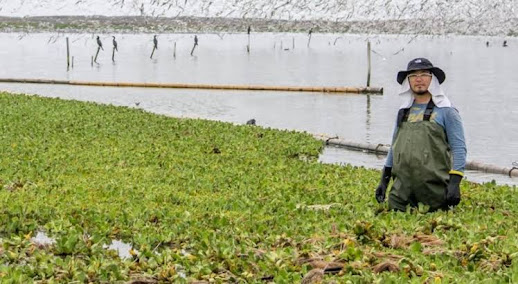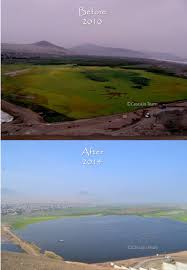There was an area of natural habitat called El Cascajo wetland. Marino Morikawa spent some of the greatest moments of his childhood there. The family memories and adventures with his father. For some reason, they stopped going there.
And time went on and he headed to Japan for his further studies. And he was there in Japan, he got a call from his father, "Do you remember El Cascajo?" his father asked. "Of course I do" he replied. " You won't believe it, but they are filling in it." his father said. He shocked and asked," what? What are you talking about?" His father said," it is so polluted and completely ruined".
And then having a holiday, he went to Peru. He said to his father," dad, take me to El Cascajo." His father said, "okay". When he reached there, he was faced with the surprise, the wetlands were green. It was completely covered by aquatic plants and algae. And he asked his father," Are you sure this El Cascajo?" His father replies sadly," yes." His father added," This is El Cascajo, and we are losing it, or we already have,". Both were quite upset.
When he got to the edge of the water, he got on his knees and he apologized for not having taken care of the habitat. He gathered up the water plants and he was faced with another surprise. The water was brown stinking and full of floating objects. And he asked himself," Well, I didn't study for nothing, did I?"
So he decided to do something. He asked so many people for help but they refused. He had decided to take his first step, but how? Then he went back to Japan. He went to the bank and withdrew all his savings. He went to other banks and took out loans. And then he flew back to Peru. Since, this project was about reviving natural habitat, before doing anything he decided to observe and monitor the area. Farms were surrounding the outside of the wetlands. There was also an illegal rubbish dump there for more than 20yrs! But the worst thing was that many of the birds were feeding directly from there. Another thing was that local drains emptied directly into the wetlands and many of them directly into the sea. And as a result, the surrounding land was contaminated.
Source: iagua.es There he decided, first, they need to get rid of outer waste. Then he designed a system to divide up the wetlands, and divided them into 8 parts, from A1 to A2 and D1 to D2. To have an organized and controlled cleaning system division was necessary. He used bamboo to mark the division.
But who is getting in the water to get rid of the lettuces? And as a gentleman, it had to be him. But he had a plan in his mind. He got in the water every day for a weak from 7 am until 8 pm just removing the water lettuces. But while doing this he could see several people passed every day. Between 70-100 people every day. And they said," Hey, are you crazy You will get I'll." And engaging them in conversation was exactly his idea. He got out of the water and explained," No, its real color is not the one you are seeing now. The true color of the wetland is fabulous." He also explained that how a natural habitat like this should be sustainable. And something happened.
Those lettuces weighed around 150kg. And they carried on cleaning and slowly the group gets bigger. One day he got up late and arrived at the wetlands at 8 am. And he was faced with this surprise, more than 100 people were working on the wetlands! They shouted out, " we are with you let's save El Cascajo!" It was a moment of immense joy seeing these people, unprotected, in the water dredging up lettuces. We ended up removing 70 tons of water lettuces from A1 alone. He used that as compost, organic fertilizer. For use on dry and barren areas to make them green and fertile. And they had great results with the cooperation of the local government program.
And the next step, they need a water treatment system. They used nanotechnology. They used both technical systems of micro-nano bubbles and other biofilters. And little by little pollutants in the wetlands were eliminated. He used clay and ceramic to build the biofilter naturally. The color of the water turned blue.
Source: teaaftertwelve.com Soon after migratory birds appeared. More than 77species! But he was a bit stressed at that time with debts, but seeing the beautiful sight of those birds. It was amazing. He looked up at the birds, and all the debts just disappeared. Now the children play there. Seeing these children he said, "I have returned to my childhood." It is something special. El Cascajo wetland now has a big family. It is called the Cascajo team.
The real-life story of Marino Morikawa teaches us, that it is our environment and it is our responsibility to keep it clean and green. Without our efforts government alone can't do anything


nice efforts.
ReplyDelete